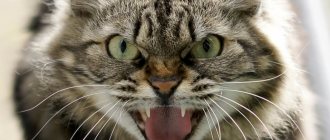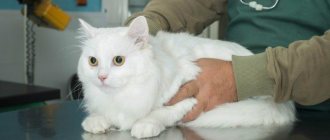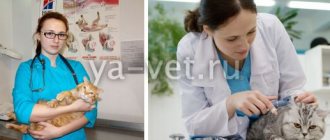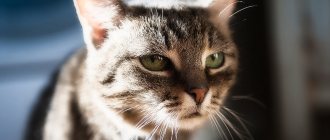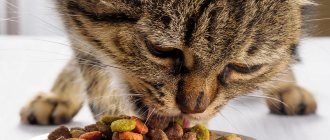Prevalence and modes of infection Pathogenesis and symptoms Diagnostics Treatment Home animal care Prevention Prognosis Feline viral immunodeficiency
(FIV or FIV) is a predominantly silent infection that is characterized by damage to the immune system. It is caused by a retrovirus, its structure and biochemistry is similar to the human AIDS virus.
Clinical signs of FIV are similar to those of HIV, but FIV cannot infect primates, incl. person. The FIV virus was first discovered in 1986 in Northern California.
Why is the immunodeficiency virus dangerous?
The danger and insidiousness of the disease lies in its latent nature. Developing gradually, sometimes over several years, the disease is not distinguished by the presence of characteristic clinical signs. The virus attacks the cells of the immune system (lymphocytes), leading to their damage and death, which adversely affects the condition of the body as a whole.
Feline immunodeficiency virus
Polymorphism of symptoms complicates diagnostic measures and early detection of infection. Tests to detect antibodies to the pathogen are technically complex, expensive and are not carried out in every veterinary clinic.
Treatment of feline viral immunodeficiency
Therapy for feline viral immunodeficiency, like HIV therapy, includes symptomatic treatment (acts on clinical signs of the disease), suppression of the activity of secondary microflora and treatment and reduction of the risk of concomitant diseases. In this case, antibiotics, corticosteroids, and, if necessary, special diets and immunomodulators are used.
In some cases, with FIV it is possible to use specific antiviral drugs that are used in human medicine in the treatment of AIDS. But they are quite toxic and, if discontinued, contribute to a greater spread of the virus and the development of a severe clinical situation.
Pathogen
The causative agent of immunodeficiency in cats is lentivirus. This microorganism belongs to the retrovirus family. It dies when boiled and does not tolerate the effects of disinfectant solutions. At the same time, the lentivirus is quite resistant to sunlight. Once in the cat's body, the lentivirus attacks the cells of the immune system. It damages and destroys lymphocytes. As a result, the animal becomes defenseless against any infection. The danger of this microorganism is that it may not manifest itself in any way for many years. Approximately 1% of stray cats are asymptomatic carriers of lentivirus.
Mechanism of action of the virus
The main route for the virus to enter a cat’s body is through damaged skin. Once in the blood, it damages mature immune cells. Infected white blood cells can no longer perform their functions, which leads to a permanent decrease in immunity. The peculiarity of the FIV virus is that it has many different subtypes or serotypes, which makes it impossible to create a strong vaccine against it.
As with HIV infection, which is transmitted by people, there have been no documented cases of recovery in immunocompromised pets.
How the disease is transmitted
Conducted scientific research and veterinary practice show that there are several ways of transmitting the pathogen to a domestic cat. The main way of contracting the infection is through contact through bites and scratches from fellow animals.
Virions are found in large quantities in the animal’s saliva and, when they enter the body with a bite, they begin to multiply unhindered. In this regard, the risk group includes uncastrated males and females. Animals get into fights with rivals and defend their territory. According to statistics, cats are more often susceptible to the disease.
Sexual transmission is one of the main methods of transmission of infection. The virus can enter the body of a domestic cat through the bite of a blood-sucking insect (fleas, ticks, etc.). There are known cases of infection of healthy animals through blood transfusion.
Laboratory research methods have also confirmed this method of transmission of the virus from a sick animal to a healthy one, such as intrauterine infection and infection during breastfeeding .
Due to the fact that the virion is unstable in the environment, quickly dies at high temperatures and is sensitive to ultraviolet light, the main route of transmission of the pathogen is direct contact of a healthy cat with a sick animal.
Ways of infection of cats
Transmission of the virus occurs by contact through the patient’s biological fluids: sperm, blood, saliva. An animal can become infected:
- during mating;
- in utero;
- during blood transfusion (blood transfusion);
- from a bite or scratch through saliva;
- during licking by an infected person (provided there are lesions on the skin or mucous membranes).
Cats living outside are more aggressive than domestic cats. To survive, they have to fight for food and shelter, so they are at risk. The number of infections is also influenced by uncontrolled matings, common among stray animals.
Spreading
About 1% of cats are thought to carry the virus. Most often found in free-ranging or stray animals. As a rule, these are animals older than 5 years. The retrovirus is circulating in cat populations around the world. Not only domestic cats, but also wild felines can become infected with immunodeficiency.
The causative agent of FIV in the body is found in saliva, blood, lymph and other fluids.
- Usually infection occurs through a bite.
- Sometimes the infection is transmitted through grooming - mutual licking.
- Intrauterine infection of kittens is possible.
- The iatrogenic route of infection is through blood transfusion.
We suggest you read: Treatment of conjunctivitis in cats, preventing infection, symptoms and causes
Who is susceptible to infection?
The feline immunodeficiency virus is widespread. Veterinary services register outbreaks of a deadly infection in all countries of the world. Both wild cats living in cities and rural areas, as well as pets that go outside for walks, can become infected.
According to statistics, stray cats and free-ranging animals are at greatest risk of contracting FIV. Considering that males more often get into fights with their relatives, protecting their territory, cats, unlike cats, are more susceptible to infection. It is also worth noting that animals of older age groups have more aggressive and antisocial behavior, so their risk of infection is higher than that of small kittens or young animals.
Important! A high percentage of cats being infected with feline immunodeficiency is noted in places where these animals gather in large numbers. That is, where cats, living in groups, are in close contact with each other.
If animals, for example, purebred domestic cats, have little contact with their relatives and go for walks under the supervision of their owners, the likelihood of horizontal infection is extremely low.
Severely weakened, emaciated individuals, cats suffering from various chronic, systemic pathologies, uncastrated males, females, pets with a weak immune system are susceptible to infection with the feline immunodeficiency virus.
The risk of contracting this infection increases in nurseries, shelters, and in places where cats are kept in groups with a dense population. If diagnostic measures are neglected and there is no control over the health of animals involved in breeding, the feline AIDS virus is quickly transmitted to other cats from latent carriers.
Symptoms and signs of infection in a cat
Due to the fact that the virus attacks lymphocytes - cells of the body's immune system, the disease is characterized by a variety of clinical signs. The cat's resistance to infections decreases, any disease becomes severe, and the body responds sluggishly to treatment.
There is no specific clinical picture for infection with feline AIDS, which significantly complicates the early detection of the disease. The severity of symptoms largely depends on the state of the animal’s immune system and the conditions of detention.
With a well-developed immune system, the clinical manifestation of the disease is reduced to fatigue, pet inactivity, and frequent infectious diseases.
In weakened animals with immunological problems, the clinical picture is more pronounced, and the first signs may appear as early as three weeks after the virus enters the body.
Veterinarians recommend that pet owners pay attention to the following symptoms:
- Apathetic state of the animal, sleep disturbance. The animal sleeps a lot and does not show physical activity. Spends most of his time in solitude. The cat avoids active games.
- Anemic condition of visible mucous membranes - pale gums.
- The animal often suffers from dermatological problems. Dermatitis of an infectious nature is observed, especially often the skin is affected by pathogenic fungi.
- Half of sick pets have dental diseases: stomatitis, gingivitis. Inflammation of the mucous membrane of the oral cavity and gums is observed, as a rule, in the initial phase of the disease.
- Increased lacrimation, chronic conjunctivitis.
- Diseases of the respiratory system, including rhinitis, laryngitis, bronchitis. Bleeding may occur from the nasal cavity.
- Enlarged lymph nodes, their pain.
- Slight increase in body temperature, possible fever.
- Many animals have digestive problems in the form of diarrhea.
- Decreased appetite, weight loss.
- In some cases, sick pets experience encephalopathy and damage to the central nervous system.
- Older animals have an increased risk of developing lymphosarcoma.
Clinical signs can accompany a sick cat for several years, either fading or worsening. Provoking factors include stress, decreased immunity, and deteriorating living conditions.
Symptoms of the disease
Immunodeficiency has several stages of development in cats.
Stage of penetration into the body
After entering the blood, the virus is introduced (replicated) into cells sensitive to it - white blood cells. At this stage, the disease does not manifest itself clearly:
- slight increase in temperature;
- inflammation of the lymph nodes;
- increased fatigue.
Incubation period (or virus carrier stage)
If the immune system is strong enough, then the immune response, although it does not lead to the destruction of the virus, prevents its active reproduction. The disease may not manifest itself in any way. This stage can last for several years. The animal becomes a carrier of the infection and can infect its fellow tribesmen. Within 2-5 years, under the influence of the virus, a significant suppression of the immune system occurs, which gives the pathogen the opportunity to become more active. During activation, a further decrease in immunity occurs.
Viral immunodeficiency
With or without the occurrence of unfavorable factors, severe symptoms appear. By analogy with the development of the disease in humans, this stage can be called acquired immunodeficiency syndrome. It is characterized by the occurrence of conditions that are dangerous and pose a threat to life:
- sudden weight loss, exhaustion;
- elevated temperature;
- skin rashes of various origins;
- enlarged lymph nodes;
- disruption of the functioning of all organs and systems;
- eye lesions;
- blood diseases;
- neurological manifestations;
- dental diseases.
A cat with FIV may develop symptoms of toxoplasmosis or lymphoma. Resistance to other infectious and fungal diseases decreases, and their course worsens. The treatment does not have the desired effect. Animals get sick for a long time and die from secondary infections.
Tests to detect immunodeficiency
In addition to a clinical blood test, which notes a low number of lymphocytes and signs of anemia, the main tests for diagnosing
Feline AIDS is an enzyme immunoassay and polymerase chain reaction method.
In addition to blood examination, other biological fluids, for example, saliva and lymph, can be analyzed.
To obtain an accurate result, the study should be carried out no earlier than 2.5 - 3 months from the moment of suspected infection. With early diagnosis, there is a high risk of obtaining a false negative result. This phenomenon is due to the fact that during this period the animal’s body does not yet produce antibodies to the ingested virion.
Kittens from an infected mother must be examined. Colostral immunity, transmitted through the mother's colostrum, in newborn animals can give a false-positive result when performing an enzyme-linked immunosorbent assay. Therefore, testing should be carried out regularly.
About the immunodeficiency virus, leukemia and diagnostic nuances, watch this video:
Treatment
Immunodeficiency refers to incurable, slow-onset infections. That is why there is no standard treatment regimen; therapy is prescribed individually to each animal depending on the stage of the disease and clinical manifestations.
Specific antiviral agents
Zidovudine (Retrovir)
Human drug for HIV-infected people. It also works for immunodeficient cats, but causes side effects - anemia, vomiting. Expensive.
While taking the drug, the cat may feel better, and the functioning of the immune system will normalize. However, after withdrawal - for example, due to a toxic effect on the body - a kind of “rollback” occurs: activation of the virus and worsening of symptoms.
Zidovudine is prescribed at a dose of 5-10 mg/kg 2 times a day, orally or subcutaneously. Once a month, your cat has a blood test to monitor his hematocrit.
It is impossible to cure immunodeficiency once and for all. The cat remains a carrier of the virus, which can manifest itself at any time.
Virbagen Omega – recombinant interferon for cats (Feline interferon-w)
They are used for life without any side effects, but in domestic practice there is still not enough information about the effectiveness of such therapy.
Immunomodulators
They are widely used for any infectious diseases, including secondary infections caused by FIV. This is more a tribute to tradition than evidence-based medicine. The effectiveness of immunostimulants is questionable not only for FIV, but also for other infections. However, harm has not been proven, so the drug market continues to expand:
- Ronkoleikin,
- Fosprenil,
- Glycopene,
- Ribotan,
- Timogen,
- Anandin,
- Polyferrin-A.
There are immunostimulants that are used for FIV with relative success:
- T-lymphocyte immunomodulator (LTCI).
Treatment of hematological disorders
The virus suppresses bone marrow activity, causing neutropenia, lymphopenia and anemia.
Neutropenia
To correct this condition, human granulocyte colony-stimulating factor is used. These are the drugs:
- Neupogen,
- Leucostim,
- Filgrastim.
Only a short course of the drug is possible - up to 3 weeks. If used longer, antibodies to the foreign protein are formed.
There is evidence that leukopoiesis stimulants increase the number of neutrophils infected with the virus. This increases the overall viral load in the blood, which is extremely undesirable.
Anemia
You can increase the number of red and white blood cells by using recombinant human erythropotin:
- Epocrine,
- Erythrostim,
- Epoetin Beta.
The drug is well tolerated by cats and can be used for a long time.
Blood transfusion gives a good, but short-term effect in severe anemia and leukopenia. Rarely used due to risk of anaphylaxis.
Fighting secondary infections
To suppress the activity of microflora, including opportunistic ones, broad-spectrum antibiotics are used over a long course.
It is ideal to determine the sensitivity of the pathogen to the drug. To achieve a quick effect, the antibiotic is sometimes combined with corticosteroid hormones in an anti-inflammatory dosage. Do not use drugs that can suppress the immune system. The reality is that even with a diagnosis of viral immunodeficiency, treatment comes down to fighting fungal and bacterial secondary infections. Causes:
- High cost of antiviral and bone marrow stimulating drugs. The price for 1 ampoule of Neupogen or Lekostim is about 5,000 rubles, a pack of 10 ampoules of Erythropoietin is about 4,000 rubles. The drug Virbagen Omega is not sold in Russia, so shuttle traders are speculating on it, bringing it from Finland and Latvia. The price for a package of 5 ampoules can reach 30,000 rubles.
- Lack of awareness among veterinarians and owners about the nature of the disease.
Diagnostics
Indirect signs of immunodeficiency are found in general clinical and biochemical blood tests, but not at all stages of the disease.
Blood Clinic:
- anemia (few red blood cells);
- neutropenia (few neutrophils);
- lymphopenia (few lymphocytes).
Biochemistry:
- hyperglobulinemia (increased protein).
If the doctor suspects immunodeficiency based on clinical signs, he prescribes a specific test: determination of antibodies to the virus in the blood. It happens that the owner wants to make sure that his pet has not become infected with FIV through bites received in a fight. In this case, the analysis is done no earlier than 3 months after the suspected infection.
There is a test system for diagnosis using the PCR method (blood taken in a test tube with an anticoagulant is examined). However, the results cannot be considered 100% reliable. They can be either false positive or false negative. If the PCR analysis data disagree with the clinical picture, serological ELISA tests are used, and vice versa.
The gold standard for diagnosing FIV is the detection of specific proteins in a sample, the Western blotting method, but such research is carried out only in specialized scientific laboratories.
Symptoms of the disease
After the incubation period (it lasts up to one and a half months), symptoms of an acute disease will appear:
- high body temperature (up to 40 degrees);
- enlarged lymph nodes (can be felt);
- diarrhea, loss of appetite, dehydration;
- lethargy, weakness, apathy;
- inflammatory and fungal skin diseases (dermatitis, lichen, etc.).
An attentive owner should notice changes in the cat’s well-being
Then comes the latent period, which lasts up to 3 years. Symptoms may disappear even if there is no treatment. At this time, the animal will continue to develop and accumulate chronic diseases, since there will be fewer and fewer lymphocytes, and the body will not be able to fight all aggressive factors. Therefore, veterinarians often detect AIDS in cats several years after infection, and the date of infection cannot be determined. No less often, specialists diagnose FIV at a stage when the animal can no longer be helped. Symptoms of chronic illnesses may include the following:
- inflammation of the mucous membrane of the gums and mouth (stomatitis, gingivitis, etc.);
- disturbances in the gastrointestinal tract (gastroenteritis, diarrhea, etc.);
- chronic runny nose, conjunctivitis, lacrimation, etc.;
- problems with the respiratory system (laryngitis, bronchitis, pulmonary edema, etc.);
- inflammation of the ear canal;
- atrophy of the lymph nodes;
- skin diseases;
- lack of appetite leading to exhaustion;
- inflammatory processes of the urinary tract.
The symptoms of a long-term disease are very diverse, so the veterinarian may not notice the virus itself. Usually, special attention is paid to all concomitant diseases, and treatment is aimed at eliminating the symptoms that cause trouble for both the cat and its owners. The lack of immunity in an animal will provoke the development of incurable diseases that will lead to its death (old cats with FIV are at risk of dying from cancer, for example, of the lymphatic system).
Photo gallery: some symptoms of a viral infection
The first symptom that appears in case of infection is high temperature
Inflamed lymph nodes can be felt on the cat's neck
Diarrhea is a common symptom when a cat is infected with the FIV virus.
Skin problems can be anything from lichen to allergic dermatitis
Lethargy, apathy, weakness are a sign of many diseases
Tests required for diagnosis
Not all specialists are able to discern the symptoms of an aggressive virus at the initial stage of its development. Signs of FIV can be identified using a number of studies:
- general clinical blood test (there will be few red blood cells, neutrophils or lymphocytes);
- biochemical blood test (increased protein content in the blood);
- determination of antibodies to the virus in the blood (if such an analysis is done on the initiative of the cat owner, then at least 3 months must pass after the expected date of infection);
- polymerase chain reaction - PCR (detection of the virus using multiple DNA amplification);
- serological ELISA tests;
- Western blotting - detection of specific proteins in the blood (this method is used only in special scientific laboratories).
Animal treatment
Specific therapy for patients with viral immunodeficiency has not been developed in veterinary practice. The main efforts are aimed at increasing the body's defenses and effectively treating concomitant diseases.
In order to activate its own immune system, the following drugs are most often prescribed to a sick pet: Roncoleukin, anti-influenza immunoglobulin, Interferon. Immunomodulators such as Fosprenil, Immunofan, Gamavit, Gamapren have proven themselves to be excellent. The dose and duration of the course are chosen by a veterinarian in each specific case.
Antiviral drugs
Vitamin therapy is mandatory for a sick animal. To strengthen the immune system, B vitamins (Riboflavin, Cyanocobalamin), ascorbic acid, vitamin A, E and D are used.
Modern antibiotics and anti-inflammatory drugs are used to treat infectious and inflammatory diseases accompanying feline AIDS. A course of corticosteroid drugs, for example, Dexamethasone, Prednisolone, gives a good result.
If necessary, the veterinarian also prescribes a special diet enriched with vitamins and minerals. Premium and super-premium hypoallergenic foods are often recommended.
A sick animal must be shown to a veterinarian regularly (at least once every three months) to monitor the development of the disease and adjust the treatment regimen.
Treatment of the disease
It is impossible to cure feline AIDS; we can only slow down the effect of the virus. Symptomatic therapy consists of two stages:
- support the cat’s immune system, inhibiting the development of the virus;
- carry out treatment of concomitant diseases.
If an animal becomes infected, it is necessary to treat it throughout its entire life, since discontinuation of medications will lead to a sharp exacerbation of symptoms. The main list of medicines used is as follows:
- Broad-spectrum antibiotics. They help fight the consequences of secondary diseases.
- Hormonal drugs (Dexamethasone, Prednisolone). Used in combination with antibiotic therapy;
- Antiretroviral drugs used to treat people with AIDS (Zidovudine). They must be taken under the supervision of a physician. There is positive experience in treating cats with these drugs.
- Recombinant feline interferon. This drug enhances the body's immune response and has a good antiviral effect.
- Immunomodulators (Immunofan, Gamavit) and vitamins B, D, E, C help support immunity.
For infected cats, treatment isn't everything. Owners should know that such an animal requires special care, which must be provided throughout its life. Its main goal is to maintain a high quality of life and minimize the risk of transmitting the virus to other animals:
- mandatory sterilization of the animal;
- maximum isolation - an infected cat should not live with other animals;
- keeping exclusively indoors;
- enhanced nutrition, which will help maintain the animal’s immune system at a high level;
- excluding raw meat, fish and milk from the diet will protect it from possible infections that are transmitted through the gastrointestinal tract;
- mandatory timely deworming and control of skin parasites;
- protection from stressful situations;
- regular preventive examinations to identify additional infections.
Preventive actions
Having an understanding of the routes of infection, the characteristics of a viral infection, the lack of specific treatment and effective vaccination, the owner must understand the need to comply with preventive measures. Veterinary specialists, based on medical practice, have developed a set of measures aimed at preventing feline AIDS:
- Mandatory vaccination of domestic cats against infectious diseases.
- Castration and sterilization of animals that are not of breeding value.
- Examination of parental couples for the presence of antibodies to the immunodeficiency virus.
- Restricting the indoor cat's access to the street.
- Avoid contact with stray animals.
- Application of quarantine measures in shelters and nurseries.
- Disinfection of places of detention and animal care items.
- Conducting regular testing of adults for the presence of the immunodeficiency virus.
- Timely treatment and prevention of infectious diseases in pets.
There is no specific prevention (vaccine) in Russia.
What is VIC
Feline immunodeficiency virus (FIV) is an infectious disease that depletes the immune system. Most often, it affects cats over the age of 5 years, who roam freely on the street or live in crowded conditions.
Description of the virus
The international name for feline immunodeficiency is FIV, or Feline Immunodeficiency Virus. It is caused by a lentivirus, which has a long incubation period. This pathogen is part of the retrovirus family and is a close relative of HIV.
The FIV virus was discovered by Americans when they found it in a Californian nursery. Despite its relationship with HIV, the feline infection has its own differences. The pathological effect of the pathogen occurs on T-lymphocytes, which are responsible for the acquired immune response. With timely treatment, a sick pet can live a long and happy life.
Danger to the animal
Due to the depletion of the immune system, secondary infections occur. Having lost its defenses, the body cannot fight back, so the animal often dies due to concomitant diseases.
An equally dangerous consequence is leukemia, that is, blood cancer. This cancer develops against the background of hematological disorders, accompanied by severe anemia (anemia).
Prognosis for a cat
The owner, having heard from the veterinarian that his furry pet has been diagnosed with the immunodeficiency virus, should not panic. Only a fifth of animals die in the first 2 to 3 years after clinical signs are detected. As a rule, this fate befalls cats with weakened immune systems and stray animals.
With proper treatment, compliance with the rules and regulations for keeping a pet, life expectancy can reach 5 - 7 years after the discovery of the disease.
Veterinarians give a cautious prognosis for the terminal stage of the disease. The life expectancy of the animal, as practice shows, in this case is no more than 2 years.
We recommend reading about anemia in cats. You will learn about the causes and types of anemia in cats, symptoms, diagnosis and treatment, feeding rules. And here is more information about the treatment of distemper in cats.
How to treat immunodeficiency virus in adult animals
Treatment does not lead to complete recovery; it slows down the effect of the viral agent. The infected cat is examined by a veterinarian and blood is taken for testing.
In a sick animal, the test will show a positive result for the FIV antibody. Kittens under eight weeks of age and vaccinated adults are not tested due to false positive results.
Drug therapy includes the use of the following drugs:
- rotivirus: Milbemax, Ribaflox;
- immunomodulators: Immunofan, Gamavit, Fosprenil;
- corticosteroids: Dexamethasone, Triamcinolone.
The veterinarian prescribes vitamins and diet.
Prevention
When keeping a cat alone in an apartment, the risk of contracting immunodeficiency is reduced to zero. In the case of walking, castration is recommended as a measure to reduce aggressiveness and territorial behavior. The immunodeficiency virus is more often found in males precisely because they tend to fight and receive more bites.
The vaccine was created and used since 2002 only in the States: Felovax - Fel-O-Vax FIV. Used from 2 months of age. Protects only 60-80% of cats from infection. Provokes post-vaccination sarcoma.
Prevention of FIV infection
For most diseases of viral etiology, vaccinations are the main preventative measure. However, in this case there is no vaccine. The only preventive measure at the centralized level is control over the population of stray animals. Owners are required to pay more attention to the hygiene of their pets and their living conditions.
An important question: is the cat immunodeficiency virus transmitted to humans? The answer is clear - this disease will not be transmitted to its owners. Studies have shown that humans are not infected with this virus.
Most owners perceive this diagnosis as a death sentence; many even want to euthanize the animals. But veterinarians are confident that this is not necessary - pets with this disease can live a long, fulfilling life. In this case, care must be taken to ensure that the animal is isolated from others.
What is more dangerous - viral immunodeficiency or leukemia?
Both viral immunodeficiency and feline leukemia are dangerous infectious diseases of domestic cats. The causative agent of leukemia is similar to the feline AIDS virus and even belongs to the same group of retroviruses. Both pathogens infect cells of the immune system. However, unlike viral immunodeficiency, with leukemia not only suppression of the immune system occurs, but also oncological damage to the liver, kidneys, intestines and other organs.
As for the prognosis for the life of an animal, leukemia, compared to viral immunodeficiency, has a more unfavorable course.
Life expectancy when feline leukemia is detected is much shorter than that of animals infected with the immunodeficiency virus.
Disease prevention
The main method of preventing the spread of infection is isolating sick animals and disinfecting dishes and trays. When keeping animals in groups, there are special precautions to prevent the spread of infection:
- Cats kept in catteries should not go outside or interact with street animals. It is important to test all cats, both living and newly admitted, for the virus once every six months. If there is a positive result, the test is repeated after 4-6 months.
- Cats must be tested for the virus before entering the shelter. Particular attention should be paid to animals with characteristic symptoms. They must be sterilized without fail.
What to do if your cat is infected? Since the lifespan of animals is much shorter than that of humans, the prognosis of the disease for them is more encouraging. If the virus was transmitted to a cat at the age of five, then no matter how many years of life she has, the disease will not have time to completely affect her body. With good care, the animal may well live for many more years without experiencing any particular health problems.
Forecast
Immunodeficiency in cats cannot be completely cured. The animal remains a carrier of the virus forever. The pathogen can be activated at any time when exposed to unfavorable factors.
Approximately 20% of animals die from secondary infections. After the first clinical manifestations of immunodeficiency, most cats live for about 5–7 years. This life expectancy is possible with good care and regular treatment.
In advanced cases and in the absence of proper therapy, the prognosis worsens significantly. Animals die approximately 2 years after the onset of severe symptoms of immunodeficiency.
Main symptoms
Symptoms of immunodeficiency in cats do not appear immediately. In 18% of those infected, the disease is asymptomatic, reminding of its existence only after the development of secondary diseases.
The first alarming symptoms can be detected after the end of the incubation period. These include:
- inflammation of the lymph nodes;
- loss of activity and appetite;
- hyperthermia (temperature rises above 40 °C);
- weight loss;
- diarrhea and severe dehydration.
With subsequent infection with other infections, the symptoms expand. At this point, the patient’s condition attracts the owner’s attention, as the clinical picture becomes more specific.
Useful video
To learn about what viral leukemia is, watch this video:
Similar articles
- Toxoplasmosis in cats: how an animal becomes infected... Toxoplasmosis appears in cats due to contact with rodents and birds. But she also becomes infected without going outside. Read more
- Anemia in cats: symptoms, types (infectious...)
What causes and how to treat anemia in cats. ... Viral leukemia, feline immunodeficiency virus are diseases of viral etiology... Read more - An abscess in a cat of the paraanal glands, tail, paws, on...
An abscess of the paraanal glands in domestic cats is fraught with the development of fistulas and... infection, the risk of developing immunodeficiency of viral etiology increases. Read more - Distemper in cats: symptoms in domestic animals, signs...
Dangerous disease - distemper in cats: symptoms, treatment and prevention. ...like feline leukemia, poisoning, pancreatitis, feline immunodeficiency... Read more - Encephalitis in cats: symptoms, treatment, vaccinations against...
How encephalitis in cats manifests and is treated. Inflammatory processes in brain tissue occur infrequently in domestic animals. Read more
Caring for a sick animal
If your pet is diagnosed with FIV, remember the following rules:
- A sick cat should not be allowed outside (this is to prevent infection of other animals and protect your pet from various infections).
- Such animals need to be neutered.
- Immunocompromised cats should not be vaccinated.
- Every six months you need to undergo examinations (body weight, examination of lymph nodes, eyes, skin, etc.).
- Blood tests (general and biochemical tests) should be performed once a year.
The owner of an infected pet will have to follow some rules for caring for the cat.
In addition, you will have to give your cat the medications prescribed by the veterinarian. If there is a risk of missing any medication, you can ask a relative. It is also worth using the services of a cat hospital. In veterinary clinics where this service is provided, veterinarians are on duty around the clock - they will give the necessary injections and give pills. I have used a similar service: it is inexpensive, and the supervision of professionals is much better than the help of relatives.
In addition, the sick cat is prescribed a diet (for this you need to consult with the treating veterinarian). The food of an infected animal must be carefully balanced and healthy.
Is FIV transmitted to humans?
The FIV lentivirus is specific in that it cannot be transmitted to humans (just as human HIV is not transmitted to cats). However, owners of infected cats will still need to exercise some vigilance.
I heard a sad story about a cat named Charlie Sheen. A red stray cat was picked up by a compassionate girl. The animal was too lethargic and weak, and its eyes almost did not open. The new owner took the cat to the veterinarian, who discovered AIDS in the poor fellow. And although the girl could not get this virus from a cat, the veterinarian warned her about other dangers.
Many people, having learned about the terrible diagnosis of their pets, move away from the animal for fear of becoming infected.
The fact is that the body of cats with FIV is an entry point for all kinds of infectious diseases. A person can “catch” secondary infections and viruses:
- ringworm (a fungus that affects the skin);
- leptospirosis (affects the kidneys and liver);
- worms;
- diseases caused by protozoa;
- rabies, etc.
That is why doctors and veterinarians recommend limiting contact of infected animals with children under 12 years of age. A child can become infected with something, because children’s immunity is still too weak and their body is vulnerable.
How to treat AIDS in a cat
As in humans infected with HIV, treatment for cats with FIV consists mainly of suppressing the symptoms of concomitant infections and reducing the risk of the underlying disease. As a rule, strong broad-spectrum antibiotics are used. Their use is scientifically justified and appropriate.
To quickly and effectively suppress the activity of concomitant infections, corticosteroids are indicated, however, such drugs give a strong but short-lived effect, so there is a high probability that the animal’s health condition may worsen after their withdrawal.
To treat animals, veterinarians use antiviral drugs, which are successfully used to treat AIDS patients. However, they must be used constantly. In the early stages of the disease, they are quite effective, but their cancellation provokes an even greater manifestation of symptoms. Another disadvantage of such drugs is that they have many side effects, in particular, they contribute to the appearance of hepatitis and anemia.
There is currently no cure for feline immunodeficiency virus. All drugs used in treatment only slow down the course of the disease, but do not destroy it.
However, the diagnosis of FIV is not a death sentence; the prognosis for four-legged pets sounds encouraging. This is due to the lifespan of cats. On average, they live 10 years, during which time the virus simply does not have time to infect the entire body.
INTERESTING TO KNOW: Plasmacytic pododermatitis of cats
Caring for an infected animal comes down to isolating it (it should not be outside) and creating the most comfortable conditions for it to eliminate the possibility of infection with other viruses. Regular treatment of fur against ticks and fleas is required.
A sick cat should be periodically examined by a veterinarian to check for new diseases. A visit to a specialist should be made at least once a quarter.
